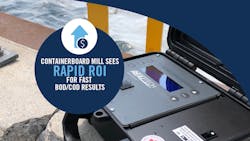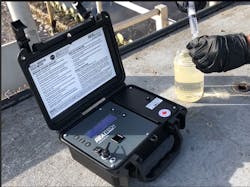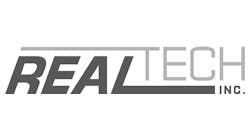Rand-Whitney Containerboard Mill Improved Processes and Ensures Compliance with Rapid BOD/COD Test Meter
Up against their BOD permit limit, the Rand-Whitney Containerboard mill in Montville, Connecticut was proactively seeking solutions that would enable them to monitor their production processes more closely with the goal to identify sources of high wastewater loading and make improvements to drive BOD down for compliance assurance. Reliance upon COD grab sample testing to aid them in understanding their plant organic loading throughout the day resulted in 3-to-5-hour delays in obtaining the results. In addition, the hazardous chemicals used in these COD tests required careful handling, disposal, and costs on top of the delays in their results.
To resolve this problem, the mill acquired a reagent free Real Tech BOD/COD testing meter. Reducing their dependency on conventional COD testing has allowed the mill to save upwards of $200 a day, and benefit from superior convenience in test measurement performance, rapid results, and low cost of ownership. With this new operations tool, the mill is now able to quickly test their wastewater for BOD and COD at several locations, helping to quickly identify source loading and make improvement to ensure their effluent is within permit limits providing a rapid ROI for their new Real Tech BOD/COD meter.
Overview
The Rand-Whitney containerboard mill manufactures linerboard used to produce corrugated packaging. Wastewater is generated in the production processes from pulping, cleaning, stock preparation, and paper forming operations. Like many industrial facilities, the mill discharges its wastewater to the local municipal sewer system with effluent limitations set out in a permit for several wastewater parameters including Biochemical Oxygen Demand (BOD) and Total Suspended Solids (TSS). Primary treatment is conducted onsite with two clarifiers to reduce TSS and BOD before final discharge to the city.
A New Approach to Wastewater Management
With limited abilities for wastewater treatment onsite, the mill is taking an innovative approach to management by focusing on production process improvements that will help lower effluent BOD, especially during peak production times when BOD levels push up against their permit limit. To identify sources of BOD, the mill required more information about water quality throughout the plant to obtain their objectives.
Stalled by Labor and Cost Intensive Laboratory Sampling
Initially, to gain better insights the mill began increasing the frequency of onsite sampling for chemical oxygen demand (COD) using the dichromate method, which produces results in 3-5 hours, an improvement over the 7-10 day wait time for BOD5 results. However, upon implementation it didn’t take long for the mill to realise this method of sampling was not practical or sustainable for their needs long-term.
This method of testing COD is very time and labor intensive, to the point where it was taking an operations staff away from their regular duties just to keep up with collecting and running samples from the various locations in the mill. Not only was this costing the mill in staff time, but there were also reoccurring costs associated with the COD vials and proper disposal of hazardous chemicals used for the test. Perhaps the biggest disappointment for the mill was the unreliability and error in COD results, often up to 15% test to test - a level that was not acceptable for their needs.
Solving Sampling Challenges with a New Rapid Testing Portable BOD/COD Meter
Burdened by COD sampling onsite, Assistant Utilities Manager Ethan Schmidt began proactively exploring alternative options for COD and BOD testing that would improve sampling efficiency at the mill. Schmidt researched and acquired a rapid testing portable BOD/COD field meter from Real Tech that utilizes UV-VIS LED technology for organics measurement. The meter generates results in seconds without the use of reagents or chemicals. “Our new BOD/COD meter is very simple to operate. For our mill, the ease of use and speed of results make all the difference. We had it equipped with a battery pack too, that allows our team to sample many locations around the mill on the spot, no need to bring samples back to the lab”.
Customized to On-Site Wastewater Conditions Improved Accuracy
Along with the BOD/COD meter, Schmidt also obtained the Liquid Ai Data Management PC software from Real Tech. Since the meter uses a correlation between light absorbance and concentration to estimate BOD and COD, the software enables Schmidt and his team to create site-specific calibrations to get the best results from his BOD/COD meter. The mill has developed and uses four different custom calibrations for both pulp water and clean water BOD and COD. “The software is simple to use and allows us to make improvements to our profiles when needed. Results from the meter are very good and meet our expectations for accuracy”.
Speedy Payback for Quick Results
With their new BOD/COD meter handling most of the day-to-day sampling, the mill was able to significantly reduce their dependency on conventional lab BOD and COD sampling. BOD5 samples are collected and sent off to the lab twice a week for permit compliance, and dichromate COD samples are now only run once or twice a week on-site to validate the new meter readings.
This has resulted in a very quick payback period for the BOD/COD meter. Schmidt estimates they are saving $100-$200 a day in sampling supplies alone - not including labor costs. “I’d highly recommend the Real Tech meter to anyone who is looking for a faster, easier, and more cost-effective way to sample BOD and COD at their plant”.
Conclusion
The Rand-Whitney Containerboard mill team now have a practical tool to continuously spot check their wastewater. Schmidt is optimistic the meter will help the mill make improvements to stay within their BOD permit limit. “We couldn’t pull the trigger on any adjustments before as we didn’t have the right data at the right time to support those decisions. Now with the Real Tech’s meter, the results are instant and reliable. We have already identified a couple processes in the mill for future improvements”
Editor's Note: Scranton Gillette Communications and the SGC Water Group are not liable for the accuracy, efficacy and validity of the claims made in this piece. The views expressed in this content do not reflect the position of the editorial teams of Water & Wastes Digest, Water Quality Products and Storm Water Solutions.




